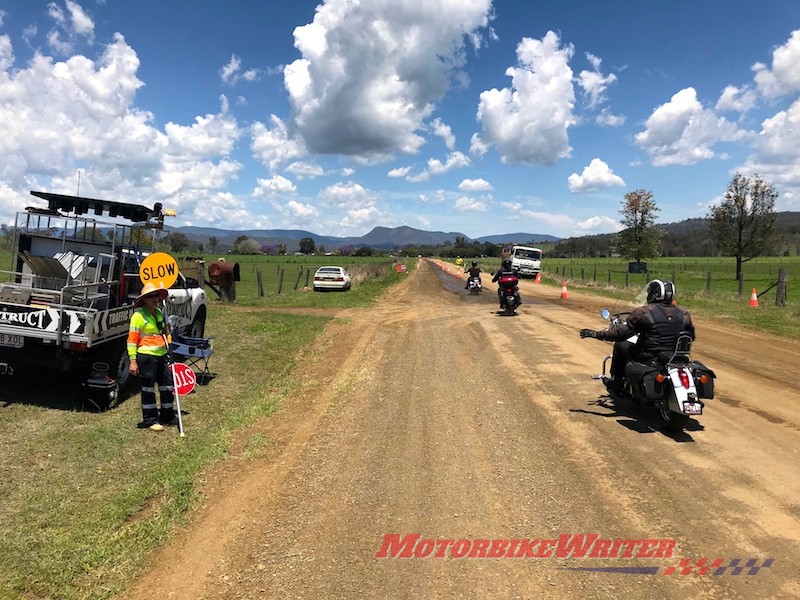Motorcyclist and road safety researcher Ross Blackman (pictured) has waded into our debate last week about whether roadworks speed limits are appropriate.
Ross works with the Centre for Accident Research and Road Safety – Queensland (CARRS-Q) at the Queensland University of Technology in the areas of both motorcycle safety and safety at roadworks.
Here is his take on roadworks speed limits:
Readers’ comments on the article offer a range of perspectives, some of which seem highly speculative. The article also makes a couple of potentially misleading points.
One of these is that roadwork speed limits in the US are only advisory. Although ‘work zone’ traffic management does vary across the many US jurisdictions, the country has produced comprehensive research and guidelines on work zone speed enforcement (see NCHRP Report 746) and has both regulatory and advisory limits. Highways in the US typically have many more lanes than Australian roads and the additional road space often allows more moderate speed limit reductions than required in Australia where roads are narrower. The US approach doesn’t achieve safe outcomes, with a current yearly average of around 600 fatal work zone traffic crashes according to NHTSA data.
In the UK, the trialling and subsequent approval of 55 – 60mph (~100km/h) highway roadwork speed limits applies, according to Highways England, to situations ‘where they could be safely implemented’. These situations include specific scenarios and conditions, including implementing the higher limits for non-workdays and when no workers are present. They are not default limits for highway roadworks. While higher speed limits can be expected to produce greater compliance, this does not necessarily lead to greater safety. As noted in the TRL report on this issue, selection of roadwork speed limits ‘should be made on a case-by-case basis’. Calls for uniformity in roadwork speed limits are understandable. However, uniform limits would logically be set low to address the highest potential risk scenarios. This conflicts with other calls for flexibility, where different speed limits may be applied as appropriate to specific conditions.\
Australia
In Australia, highway roadwork speed limits are typically progressive, with initial warning signs (e.g. Roadwork Ahead/Reduce Speed) placed at least several hundred metres upstream of (before) a work area, followed by speed limit reductions down to 60km/h, and in some situations 40km/h. A 40km/h speed limit will only normally apply on high speed roads where there are no barriers in place and when workers may be operating close to the live traffic lane. Otherwise, the typical reduced speed limit on highways will be 60km/h. There would be very few, if any, situations where an immediate 100 to 40km/h speed reduction is applied without prior warning at roadworks. However, poor compliance with reduced speed limits on approach to work areas indicates that many motorists either fail to see or do not respond adequately to warnings and speed reduction requests. As noted in a 2017 Austroads Report, this is a source of downstream traffic conflicts and a major factor in rear-end crashes which are the most common roadwork crash types. Tailgaiting doesn’t help.
The issue of roadwork speed limits at unattended and apparently inactive sites (and associated complacency among motorists) is one that has attracted considerable research attention and of which road authorities are acutely aware. From a safety perspective, there are several important issues here. One is that the task of installing and removing signage is in itself a high risk activity for traffic controllers – this is a situation where workers are known to have been killed or injured, such that in many cases it may be considered safer overall to leave signage in place. Reduced speed limits may also be left in place at inactive sites where conditions may be hazardous. The most obvious for motorcyclists may be loose or rough surfaces, but there are other potential hazards such as altered delineation, lane width and lack of line markings, for example. Speed reductions may also be left in place for some time after the completion of work to allow loose aggregate to be embedded in newly laid asphalt by passing traffic. While a roadwork site may not present any apparent hazards for some road users, numerous serious and fatal crashes do occur at inactive sites.
We all want better roads, for our safety as well as our enjoyment. Improvement and maintenance of this infrastructure unfortunately involves some disruption and inconvenience, for motorcyclists as well as other road users. I wonder if some of the people complaining about road conditions are also among those who complain about roadworks. Current arrangements and traffic control measures are far from perfect, but work is ongoing in Australia and elsewhere to improve the safety, efficiency, and management of roadwork operations. Driving or riding through roadworks sometimes causes delays, which can usually be anticipated and managed with a little preparation. Working on roads is a high-risk occupation and those involved have a right to return home safely at the end of the day, just as all road users do, including motorcyclists.




